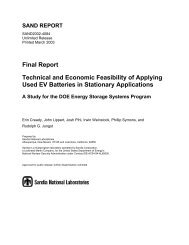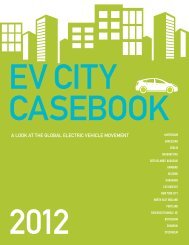Fleet Electrification Roadmap
Fleet Electrification Roadmap
Fleet Electrification Roadmap
- No tags were found...
You also want an ePaper? Increase the reach of your titles
YUMPU automatically turns print PDFs into web optimized ePapers that Google loves.
36 primer: electrification of the transportation sectorspecial sectionspecial sectionfleet electrification roadmap 37FIGURE P18Well-to-Wheels Emissions: PHEV-40 in CD ModeFIGURE P19Well-to-Wheels Petroleum UseThe Benefits of Electricity450 Grams of CO 2 per Mile400350300250200150100500NY - ISOILConventional GasolineHEVWECCCAPTW (On-Board)WTP (Electric)WTP = Well-to-Pump; PTW = Pump-to-Wheels; CD = Charge Depleting; CS = Charge SustainingFIGURE P20Oil Intensity of the U.S. Economy (Real $2005)1.2 Barrels of Oil / $1,000 of GDP1.00.80.60.40.2019651970197519804,500 BTU per Mile4,0003,5003,0002,5002,0001,5001,0005000PTW(On-Board)PHEV-10 CDPHEV-10 CSConventional GasolineHEVPHEV-40 CDSources: Figure P18, P19 — Argonne National Laboratory; Figure P20 — U.S. Bureau of Economic Analysis; BP, plc., Statistical Review of World Energy 2010standpoint. Electric vehicles—and series plug-in hybridelectric vehicles operating in charge-depleting mode—essentially use zero petroleum to propel the vehicle. Insome configurations, PHEVs with smaller batteries maystill use some petroleum, but the total amount can benearly 50 percent lower than from an HEV. 69 Meaningfulpenetration of EVs and PHEVs, along with traditionalHEVs and more efficient ICE vehicles, would radicallyimprove U.S. energy security by minimizing the role thatpetroleum plays in the national economy.Between 1975 and 1985, the United States sharplyreduced the amount of petroleum that went into producingeach dollar of gross domestic product. 70 The practicalelimination of oil from the electric power sector and69 Id.70 BP plc, Statistical Review of World Energy 2010, at 11; U.S. Bureau ofEconomic Analysis; and SAFE analysis.1985199019952000WTP (On-Board)PHEV-40 CS2005the implementation of the first national fuel economystandards led to oil intensity reductions averaging 2.5percent per year. Beginning in 1985, however, the rateof reductions in oil intensity slowed dramatically. Acrash in oil prices strongly contributed to changingconsumer demand in vehicle performance and fuel efficiencymetrics. Over the following decades, reductionsin oil intensity averaged less than 1 percent annually, asimprovements in fuel-economy standards stalled and theautomotive industry invested research and developmentdollars in increasing horsepower instead of the advancementof new, efficient technologies.The arrival of electric-drive vehicles in the marketsignals the beginning of a fundamental shift in U.S. energysecurity dynamics. With oil demand growth in emergingmarket economies providing steady support for higher oilprices, consumers may be much more willing to invest inefficiency if the product options are compelling.2010Grid-enabled electric drive technologies—PHEVs andEVs—will benefit from important characteristics of theU.S. electric grid. Vehicle miles powered by electricity willoffer improved energy security, reduced fuel costs, andreduced CO 2 emissions largely because the power sectoroffers material improvements in those categories comparedto petroleum.Electricity is Diverse and Domestic: Electricityis generated from a diverse portfolio of largely domesticfuels, including coal, uranium, natural gas, flowing water,wind, geothermal heat, the sun, landfill gas, and others.Among those fuels, the role of petroleum is negligible. Infact, just 1 percent of power generated in the United Statesin 2009 was derived from petroleum. 71An electricity-powered transportation system, therefore,is one in which an interruption of the supply of onefuel can be made up for by others, even in the short term,at least to the extent that there is spare capacity in generatorsfueled by other fuels, which is generally the case. Thisability to use different fuels as a source of power wouldincrease flexibility in the transport sector. As nationalgoals and resources change over time, the United Statescould shift transportation fuels without overhauling itstransportation infrastructure.In addition to this diversity of supply, the fuels usedto generate electricity are generally sourced domestically.All renewable energy is generated using domesticresources. The United States is a net exporter of coal.In 2009, only 12 percent of natural gas demand wasmet by imports, and approximately 90 percent of thoseimports were from North American sources (Canada andMexico). 72 The United States does import a substantialportion of the uranium that fuels civilian nuclear powerreactors. Forty-two percent of those imports, however, arefrom Canada and Australia. 73Electricity Prices are Stable and RelativelyInexpensive: Electricity prices are significantly lessvolatile than oil or gasoline prices. Over the past 25 years,electricity prices have risen steadily but slowly. Since1983, the average nominal retail price of electricity deliveredin the United States has risen by an average of lessthan 2 percent per year in nominal terms and has actually71 DOE, AER, Table 8.2a.72 DOE, AER, Table 6.3.73 DOE, EIA, 2008 Uranium Marketing Annual Report (UMAR 2009) p. 1(2009).FIGURE P21Retail Electricity & Gasoline Prices$30 per Million BTU (Nominal)25201510501960Average RetailElectricity19681976Source: DOE, AER 2010; EC AnalysisAverage RetailGasoline2000fallen in real terms. 74 Moreover, nominal prices have risenby more than 5 percent year-over-year only three times inthat time period. 75 This price stability, which is in sharpcontrast to the price of oil or gasoline, exists for at leasttwo reasons.First, the retail price of electricity reflects a widerange of costs, only a small portion of which arise fromthe underlying cost of the fuel. The remaining costs arelargely fixed. 76 In most instances, the cost of fuel representsa smaller percentage of the overall cost of deliveredelectricity than the cost of crude oil represents as apercentage of the cost of retail gasoline. 77 For instance,although fossil fuel prices rose 21 percent between 2004and 2006 (as measured on a cents-per-Btu basis), andthe price of uranium delivered in 2006 rose 48 percentover the cost of uranium delivered in 2004, the nationalaverage retail price of all electricity sales increased only17 percent. 78 This cost structure promotes price stabilitywith respect to the final retail price of electricity.Second, although real-time electricity prices arevolatile (sometimes highly volatile on an hour-to-hour or74 DOE, AER 2009, Table 8.10.75 Id.76 DOE, EIA, “Energy in Brief-What Everyone Should Know: How is myElectricity Generated, Delivered, and Priced?” available at http://tonto.eia.doe.gov/energyexplained/index.cfm?page=electricity_in_the_united_states.77 DOE, EIA, “Gasoline Explained: Factors Gasoline Prices” available athttp://tonto.eia.doe.gov/energyexplained/index.cfm?page=gasoline_factors_affecting_prices.78 DOE, EPA 2007, Table 4.5; DOE, UMAR 2009, Table S.1.b; DOE, AER2008, Table 8.10.198419922008
















